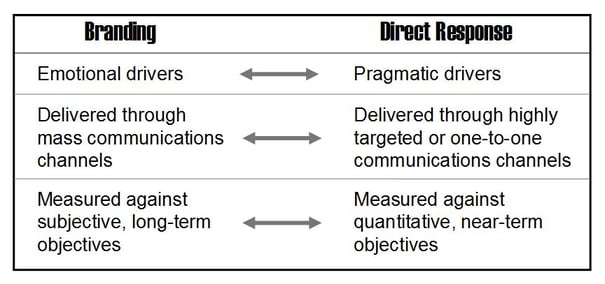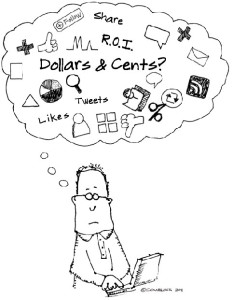For many B2B marketers, a brand building marketing strategy can mean pulling budget from product-focused marketing initiatives that directly drive response or purchase with the target audience. All too often branding is treated as a mutually exclusive marketing strategy set distinctly apart from the response-based strategies used in product- or solution-focused marketing efforts.
In fact, responsibility for brand strategy and product marketing often resides in different departments. For those organizations, the answer to bridging this gap is typically instituting formalized brand usage guidelines. And while it’s one element of successful branding, a unified look driven by corporate identity standards is sometimes mistaken for implementing an integrated brand strategy.
It is easy to understand why branding and direct response strategies have historically been isolated. The messaging, media and metrics used to guide each are polar opposites by definition.
The Great Abyss
Strong, relevant brands have identified the emotional drivers associated with their value and have successfully integrated those emotional pulls into the messaging, tone, and imagery aimed at the target audience. On the other end of the spectrum, successful direct response relies on the pragmatic purchase decision levers with offer strategies that drive a particular action such as a limited time value-added benefit or price break.
Beyond the corporate identity, brand strategies are often synonymous with large branding campaigns communicated most frequently through trade publications in B2B markets, but also through television and radio. Comparatively, direct response has predominantly been implemented through one-to-one media such direct mail and, more recently, interactive media.
Finally, branding success is measured over time against softer brand awareness and recognition metrics, while direct response is measured immediately through definitive response rates and sometimes actual transaction levels.
Given the difference in approach, media and metrics, it is easy to understand why most B2B marketers do not have the budget or resource to fully support both brand and product advertising strategies. As a result, neither typically gets accomplished very well as part of addressing the target audience in a marketing strategy.
Closing the Gap
But what if you could fuse the benefits of direct response and brand advertising? If successful, you would ensure the core values of your brand were consistently communicated to the target audience and at the same time drive directly measurable results. Using a hybrid approach that integrates the right mix of brand message and response options/offers, along with a performance-based media strategy, can maximize a marketing budget and drive branding and product marketing results.
By definition, good marketing builds the brand and sales by effectively identifying and measurably motivating a decision maker or influencer to take a desired action while continually reinforcing a desired belief. The road map to integrating the benefits of these two marketing strategies can be illustrated through two key B2B marketing tools. The common denominators in B2B media strategy tend to be direct marketing and trade pub advertising; nearly all B2B marketers use both media more heavily than TV, radio or even interactive. Using a direct branding philosophy, the approach to developing and executing each medium would look a little different.
A Marketing Strategy with with Message and Metrics
It’s a messaging challenge. The direct strategies used to motivate a decision maker or influencer to take action now can be counter-productive to the overall brand if not executed properly. The brand message tends to get lost or more likely traded off for messaging that supports only the product features and benefits as well as the call to action. Take the time to weave in your brand.
The insights that drive successful direct marketing are usually very data driven, such as business or demographic descriptors, to drive list source evaluation and acquisition. The insights allow you to target the right audience for the highest anticipated response. That shouldn’t change. However, integrating in the insights that drive strong brand definition shouldn’t be overlooked. Branding insights are dialog driven to ensure relevant messaging. There is a heavy focus on understanding the motivators as defined by the customer needs and expectations which is often overlooked in developing direct campaigns or mailers.
If it hasn’t already been done within your organization, identify the two or three key brand message points that need to come across at every point of communication with your target audience and infuse those message points through copy, imagery and/or tone of the piece.
Now you’ve successfully integrated your brand, not just your logo, into your direct response strategies. And with every direct interaction, you build brand relevance and equity.
Infusing Direct Marketing Strategy into Branding Initiatives
Isn’t every message, regardless of the medium used to deliver it “one-to-one”? Ultimately, the goal is to connect with the reader if we’re communicating through trade publication advertising. But what does “connecting” mean? In traditional branding terms, it means we’ve instilled the desired belief about our brand.
That isn’t enough for B2B marketers working on shoestring budgets which is why pure branding campaigns are rarely leveraged. If the ad could instill that brand belief and entice them to take some type of action – link to a Web site to learn more about the company or product, request more information or even purchase – then you’d have a strong direct branding ad.
Integrating solid direct response strategy into mass media is accomplished in two ways:
- Including a call to action that drives the reader to a centralized point of contact like a Web site, landing page or an 800 number. The ultimate value lies in response/leads you can measure and the opportunity for one-to-one contact over time. In addition, it enables a real measure of interaction with your brand.
- Weighting the media strategy toward performance-based media buys instead of simply relying only on the traditional reach and frequency plan. This is a balancing act, but increasing media spend with publications that actually generate stronger response to your offer is like increasing spend with a particular list source that’s generating the highest response to your direct campaign. You wouldn’t keep mailing to a list that doesn’t respond. Balancing the brand exposure benefits of traditional reach and frequency media strategy with productivity based on interest/response generated is a critical element of a solid direct branding strategy.
Now you’ve successfully integrated the value of driving leads and direct measurement of relevant interaction with your brand into your branding initiatives. – Barb Murphy
The Brainzooming Group helps make smart organizations more successful by rapidly expanding their strategic options and creating innovative plans they can efficiently implement. Email us at info@brainzooming.com or call us at 816-509-5320 to learn how we can deliver these benefits for you.






